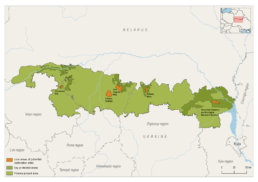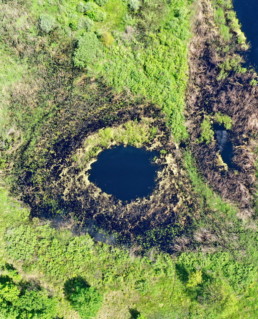Lva Floodplain
The Lva Floodplain was protected thanks to our project. It comprises a large area of deciduous forest and a variety of wetland habitats in the floodplain of the Lva River, between the Garyn River valley and the Almany Mires. The nature reserve is an important link in the national ecological network.
The Lva River’s bed, 10-25 meters wide, is meandering, occasionally dammed up and lost in vegetation. It forms a diversity of wetland habitats.
Deciduous waterlogged forests occupy an important place among the valuable habitats of this area. Besides, there are waterlogged sedge meadows, mixed herb/cereal and sedge meadows and swamps along the Lva riverbed. All together, they are home to an impressive biodiversity.
In the 1970-1980s, the vast swamplands of the Lva floodplain were partially drained, and a large reclamation system was created in the central part of the area, which has had a negative impact on the hydrological condition of the site. Now, the reclaimed areas are mainly used for grazing and haying and partially cultivated.

Country: Belarus
Area: 2,400.0 ha
National protection status: Nature Reserve
International protection status: Emerald Network* (BY0000049) – Lva Floodplain (17,710.4 ha); IBA (BY030) – L'va floodplain (16,854 ha).
* After denunciation of accession to the Bern Convention on the Conservation of European Wildlife and Natural Habitats, de jure there are no Emerald Network sites in Belarus.
The following description relates to the former Lva Floodplain Emerald Network site.
>2%
of the national population of the Greater Spotted Eagle are found here
20 key habitats
are included
in Resolution #4
of the Standing Committee
to the Bern Convention
588 species
of vascular plants are identified in the area
Biodiversity and natural values

Habitats
The area boasts diverse wetland and woodland habitats. About 20 of them are listed in Resolution No. 4 of the Standing Committee of the Bern Convention as requiring specific protection measures.
Aquatic Habitats
- Free-Floating Plant Rafts and Mats (3150) – Floating Water-Soldier Rafts, Floating Bladderwort Colonies, Floating Salvinia natansMats, General Free-Floating Vegetation of Eutrophic Waterbodies;
- Rooted Underwater Vegetation (3150) – Rooted Submerged Vegetation of Eutrophic Waterbodies;
Wetland Habitats
- Transition Mires and Quaking Bogs (7140),
- Beds of Large Sedges (7210)– normally without free-standing water;
Forest and Woodland Habitats
- Riverine Woodlands (91E0): Riverine Willow Woodland; Riverine Ash – Alder Woodland (wet at high water but not at low water),
- Upland & Bog Woodlands: Sphagnum Birch Woods (91D0) – forests that grow in bogs; Oak – Ash – Hornbeam Woodland (9170) – forests on nutrient-rich soils.



Biodiversity
The site is an important habitat for a globally endangered species – the Greater Spotted Eagle (Aquila clanga) (more than 2% of the national population); about 1% of the national populations of the Terek Sandpiper (Xenus cinereus) and the Hen Harrier (Circus cyaneus) have also been observed breeding there. Breeding sites of the Short-toed Eagle (Circaetus gallicus), the Lesser Spotted Eagle (Aquila pomarina), and the White-tailed Eagle (Haliaeetus albicilla) are registered here. Several breeding seasons of the Great Snipe (Gallinago media), the Black-tailed Godwit (Limosa limosa), the White-backed Woodpecker (Dendrocopos leucotos), and the Azure Tit (Parus cyanus) were recorded. Six plant species listed in the Red Data Book of Belarus have been identified there. As many as 588 species of vascular plants occur in the area.
The most important impacts and threats

Meadows overgrowing with scrubs

Dead wood removal, sanitation felling

Old drainage systems
Protection and conservation needs
Part of this area is protected as a nature reserve of local importance, where economic activities are restricted. Part of the habitats of protected species and valuable biotopes are under the protection of land users. However, the condition of the area needs to be improved, and it needs more efficient conservation measures. The following ones are recommended by experts:
- Make a detailed inventory of the conservation values (species habitat and natural complexes),
- Ensure their protection by creating special protection zones/plots;
- Launch ystematic monitoring of conservation values;
- Develop a management or conservation plan for the area.
Our activities in the area
The project staff initiated the designation of the nature reserve on the area of 2400 ha. The necessary scientific research and preparation of documents were carried out as part of the project.
Rare biotopes and habitats of species listed in the Red Data Book of Belarus were identified and protected in order to ensure the preservation of the natural values of the Emerald Network object “Lva Floodplain”.



The project “Polesia – Wilderness Without Borders” is part of the Endangered Landscapes & Seascapes Programme and is funded by Arcadia. The project is coordinated by Frankfurt Zoological Society (FZS).

